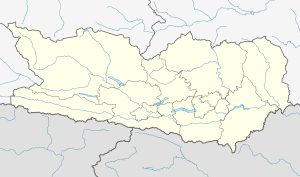Falkenstein Bridge
Coordinates: 46 ° 55 ′ 28 ″ N , 13 ° 14 ′ 25 ″ E
| Falkenstein Bridge | ||
|---|---|---|
| Convicted | Tauern Railway | |
| place | Obervellach - Pfaffenberg | |
| construction | Arch bridge | |
| overall length | 396 m | |
| width | 10 m | |
| Longest span | 150 m | |
| Arrow height | 46.0 m | |
| Arrow ratio | 1 / 3.26 | |
| height | 90 m | |
| building-costs | 91 million schillings | |
| start of building | July 30, 1971 | |
| completion | 1973 | |
| opening | July 13, 1974 | |
| location | ||
|
|
||
The Falk stone bridge with 396 meters the longest bridge of the Tauern railway and one of the largest railway bridges of Austria . The two-track structure is located in Carinthia near Obervellach , near Falkenstein Castle , and spans a transverse valley of the Mölltal with two arches. It was built between 1971 and 1973 as part of the realignment.
The layout of the route is straight in the structural area and has a gradient of 27.62 ‰ in the direction of Schwarzach.
construction
The Falkenstein Bridge is an arched bridge , consisting of two geometrically analogous arches with a span of 120 m and 150 m. The 7.5 m wide sheets each have a two-cell reinforced concrete on -Kastenquerschnitt, which in the flat established is clamped fighter foundations. The arch with a 150 m span and an arrow height of 46 m has a cross-sectional height of 3.0 m at the top and 4.8 m at the fighters . The shorter arch has an arrow height of 36.8 m and a cross-sectional height of 2.5 to 4.0 m.
The 10 m wide and constantly 2.62 m high superstructure made of reinforced concrete has a continuous ballast bed. The three expansion joints with rail extensions are arranged at the ends of the bridge and between the two arches. The individual spans of the 396 m long track structure are 2 × 19.75 m, 0.55 m, 8 × 15.7 m, 0.55 m, 10 × 15.7 m, 0.55 m, 3 × 24.00 m . There is a four-web T- beam cross- section above the arches with a 15.7 m span . The 0.4 m wide and 1.8 m high beams are arranged at a distance of 2.0 m. In the foreland areas with up to 24.0 m long spans, the cross-section is supplemented by a base plate to form a three-cell box cross-section.
The 2.3 m wide bridge piers and 1.5 m wide arched posts have two-cell reinforced concrete cross-sections. They are monolithically connected to the superstructures and arches or foundations. Bearings are only available at the abutments .
history
Construction began and the first blasting took place on July 30, 1971. The 1.296 kilometer long “Falkenstein bypass” construction lot was located between the Mallnitz-Obervellach and Penk stations. The new section shortened the route by 167 m, increased the radius of curvature from 250 m to 450 m and increased the top speed from 60 km / h to 90 km / h. In addition to the 48 m long Gratschacher Viaduct, the Leutschacher Tunnel (247 m), Falkenstein Tunnel (67 m) and the Gratschacher Tunnel (358 m) were replaced by the construction of the new section. A total of 59,000 cubic meters of rock and earth were moved, 28,000 cubic meters of concrete processed and 1,580 meters of catenary wire installed.
The Pfaffenberg Bridge is about 1 km further downhill on the same route .
execution
The arches were built on a self- supporting falsework by gradually building up the arch cross-section. The construction of the bridge took 20 months.
literature
- Franz Aigner: Falkenstein Bridge, Austria. In: Gerhard Mehlhorn (Ed.): Handbook bridges. Springer, Berlin / Heidelberg 2007, ISBN 978-3-540-29659-1 , p. 164.
- The ÖBB in words and pictures 9/1974: The new Falkenstein Bridge opened and opened to traffic , Vienna 1974, pp. 21-25.

